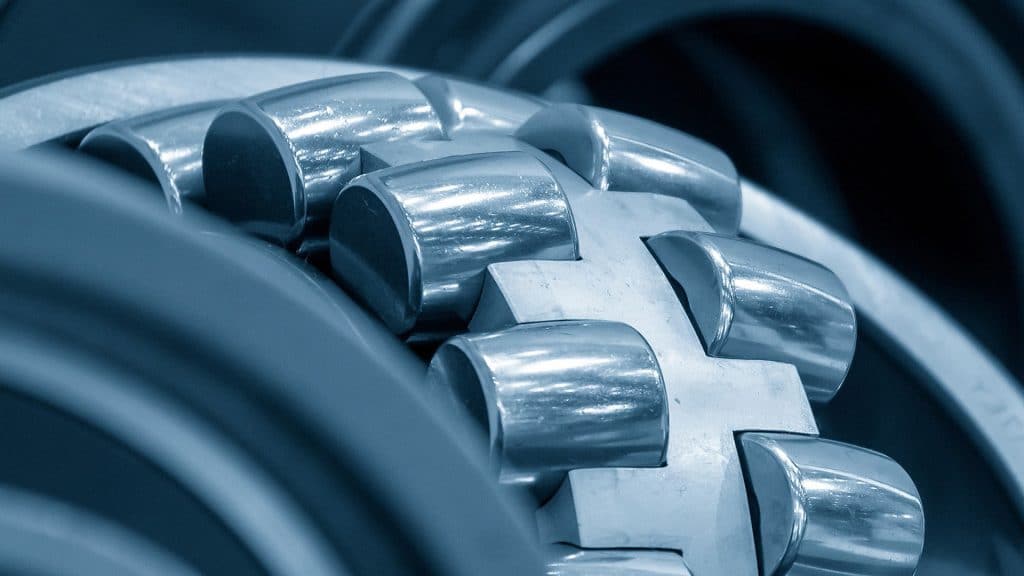
In our series on fighting metal failures, we’ve provided an overview of the different types of corrosion and abrasion. Now, we’ll examine rolling contact fatigue’s role and impact on metal machinery and components.
Rolling contact fatigue (RCF) is a specific mode of metal failure in machine components subjected to repeated rolling and sliding contact. From bearings and rollers to camshafts to gear teeth, various applications experience RCF — often in conjunction with other issues, such as bending, axial, thermal, abrasion, and corrosion. These types of stresses, in combination with rolling contact fatigue, can hasten the propagation of cracks and, ultimately, material deterioration and malfunction.
Here, we’ll provide an overview of the different types of rolling contact fatigue, its causes, and preventive measures your business can take to mitigate risk.
The Manifestation of Rolling Contact Fatigue
Mechanical and microstructural changes in the metal beneath the contacting surfaces are responsible for RCF. Here is how it typically manifests:
-
Subsurface Stresses
Unlike other forms of fatigue caused by surface stresses, RFC often initiates just below the contact surface due to the distribution of stresses. The maximum stress usually occurs beneath the surface.
-
Material Changes
As components roll against each other, repeated cycles of loading and unloading of the material occur. The repeated load cycles cause deformation of the metallic structure, leading to the formation of microcracks initially beneath the surface.
-
Crack Propagation — White Etching Cracks (WECs)
White etching cracks are subsurface cracks that form in the bulk of the material beneath the surface. These cracks, characterized by a white appearance when examined in a metallurgical laboratory, are associated with high-contact stress and cyclic loading.
-
Pitting, Spalling, and Flaking
When these cracks reach the surface, small pieces of the material can detach, leading to surface defects known as pits. Continuous detachment from these pits can cause spalling, which is when larger fragments of material are removed from the surface. Flaking is a severe form of spalling where still larger fragments of material break away from the surface, leaving behind cavities or depressions. Flaking can result in significant component damage and reduced load-carrying capacity.
Effects of Rolling Contact Fatigue Across Industries
Component failure due to RCF can lead to significant operational, financial, and reputational costs across a variety of industries:
Aerospace
In the aerospace industry, rolling contact fatigue is a significant concern, primarily because of the critical nature of aerospace components.
- Aircraft Bearings: Jet engines and many aircraft systems incorporate various bearings subjected to high rotational speeds and loads.
- Landing Gear Systems: During landings and taxi operations, aircraft landing gear systems’ wheels and associated components are subjected to rolling contact loads. While they don’t experience the continuous operation of a railway system, the high loads associated with aircraft landing (combined with potential debris on runways) can induce RCF.
- Helicopter Systems: Helicopter gearboxes and associated systems also involve rotating components in rolling contact. As helicopters operate in more varied environments than most fixed-wing aircraft (e.g., dusty or maritime conditions), their components may be exposed to conditions that exacerbate RCF.
Oil and Gas
Components utilized in oil and gas extraction are subjected to dynamic loads — especially in heavy-duty equipment with rotating and rolling parts. Ensuring the reliability and durability of equipment is crucial because a failure can lead to financial losses, potential environmental hazards, and safety risks.
-
- Drilling Operations: Downhole drilling tools and top drives incorporate bearings and other components that experience RCF.
- Mud Motors: Downhole drilling motors that use drilling fluid (“mud”) to power a drill bit operate under harsh environments. As a result, bearings and other rotating components within mud motors are susceptible to RCF.
- Pumps: Oil and gas operations use various pumps, like centrifugal and positive displacement pumps, to transport fluids. Bearings and other rotating components in these pumps can be prone to rolling contact fatigue.
- Compressors: Gas compression systems, crucial for gas transmission and processing, also have rotating elements, increasing their risk for damage.
Transportation
Rolling contact fatigue plays a significant role in transportation, especially in the automotive and rail sectors.
- Wheel Bearings: Wheel bearings are crucial for smooth operation in rail and auto applications. However, these bearings are susceptible to RCF, especially in heavy freight trains that carry substantial loads over long distances.
- Transmission Gears: Gears inside the transmission are subjected to rolling and sliding contact. RCF can lead to pitting on the gear surfaces, further deteriorating the smooth operation of the transmission.
- Differentials: The differential, which allows wheels to rotate at different speeds when the vehicle turns, contains gears that are susceptible to rolling contact fatigue.
Industrial Machinery
From food processing and packaging equipment to pumps and compressors, industrial machinery frequently utilizes rotating elements. Understanding wear mechanisms like rolling contact fatigue can help ensure reliable operation and maintain product quality.
- Conveyor Systems: Many food processing plants use conveyor systems to transport raw materials, semi-processed food, or finished products. Rollers and bearings in these conveyor systems can experience RCF, particularly in high-throughput operations.
- Mixers and Grinders: Machines that mix ingredients or grind food products have rotating components, and the bearings in these machines often operate continuously or under high loads.
- Filling and Sealing Machines: These machines often have rotary components to fill and seal packages. The rotating elements, if not well-maintained or lubricated, can experience wear.
- Pumps and Compressors: Bearings in pumps and compressors enable shafts to rotate smoothly and efficiently. The repeated rolling contact between the bearing elements (balls and rollers) and the races can lead to rolling contact fatigue.

Roller conveyor of automatic production line of manufacturing process for transportation material goods
Preventive Measures and Maintenance Practices
Electrolizing® thin dense chrome coating helps prevent rolling contact fatigue due to several attributes. First, Electrolizing® reduces the coefficient of friction (COF). Surfaces engaged in rolling contact also undergo a degree of sliding motion, influenced by various factors such as operational conditions, machining precision, assembly tolerances, and lubrication circumstances. Minimizing the coefficient of friction can mitigate the adverse effects of sliding.
Next, Electrolizing® counteracts RCF because the coating can endure unfavorable lubrication conditions, driven by two primary factors: resistance to corrosion and resistance to wear. Given that rolling contact fatigue frequently originates from minute surface imperfections, the presence of corrosion pits can be particularly detrimental. Electrolizing® coating boasts effective corrosion prevention properties, which aids in reducing susceptibility to damage caused by oils with excessive moisture content or high oxidation levels (resulting in acidity).
Beyond corrosion, the application of Electrolizing® coating increases resilience to lubricants contaminated with abrasive particles. Like corrosion pits, these hard particles can create microscopic indentations on metal surfaces, serving as initiation sites for RCF.
Additional preventative measures and maintenance practices include:
- Material Selection: Choose materials with high fatigue resistance and suitable hardness for the application’s loading conditions. Use specialized coatings (such as thin dense chrome) and surface treatments to enhance material performance.
- Lubrication Optimization: Ensure consistent and adequate lubrication to minimize friction and wear.
- Design Improvements: Optimize component geometry to distribute stresses more evenly.
- Operational Changes: Adjust loading conditions, speeds, and operational parameters to reduce stress concentrations and fatigue damage.
- Maintenance Practices: Regularly inspect components for early signs of wear, cracks, or damage.
Operational Benefits of Electrolizing®
Utilizing protective coatings like Electrolizing® thin dense chrome, while implementing other preventive measures and maintenance practices, can effectively mitigate rolling contact fatigue, extend the lifespan of components, reduce downtime, and enhance overall operational reliability. Learn how the Armoloy Innovation Center experts can help your organization combat metal fatigue.